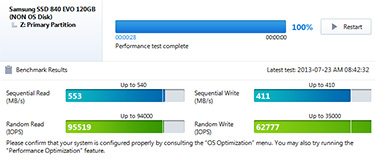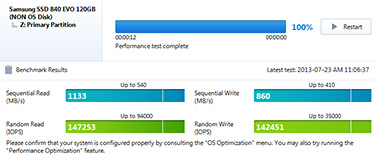New Tricks, New Speeds
TurboWrite, as the name suggests, is a means of increasing the drive's write performance. To achieve the desired effect, the 840 EVO configures a portion of its onboard NAND in a single-level-cell (SLC) mode to act as an exclusive cache for data writes. The drive, by default, is configured to use triple-level-cell (TLC) memory, but by setting a portion aside in this pseudo-SLC mode, Samsung is able to harness the higher write performance available to single-bit-per-cell flash.
This write-only cache is used to quickly store all incoming data, until full, with the controller then moving the data to main storage when the drive is idle. The size of the cache is linked to total capacity and varies between 3GB on the 120GB model and 12GB on the 1TB drive. The benefits of TurboWrite will be felt most keenly on smaller 840 EVO models, with Samsung stating that the 120GB drive would manage a sequential write speed of 140MB/s without TurboWrite in action, compared to 410MB/s when the cache is being used. A near 3x improvement is not to be scoffed at.
A Samsung 840-Series drive with a higher-clocked controller and TurboWrite should already represent excellent consumer-grade performance, but why stop there? The other trick up the EVO's sleeve, dubbed RAPID Mode, is effectively another level of cache used to drastically increase both read and write performance.
RAPID Mode is a product of Samsung's 2012 acquisition of Nvelo, a software-caching specialist. The developer's most high-profile solution - Dataplex - was licensed and used by various manufacturers as a method of using a small SSD as a cache for a traditional hard disk.
Dataplex worked well, but Samsung's kicking things up a gear by changing the source of the cache and the storage device. Instead of using an SSD to speed-up a hard disk, RAPID Mode uses ultra-fast system DRAM to speed-up the SSD.
Implemented as a software layer between the OS and the SSD, RAPID Mode is made available as part of the Samsung Magician utility and, though it will initially support only the 840 EVO drive, compatibility with the 840 PRO is expected in a later update.
Samsung's keeping the details of its caching algorithms close to its chest, but we're told RAPID Mode can use up to 1GB of system memory to cache frequently-accessed data, and that the technology "focuses on improving random performance with low queue depth and small-size data."
The speed advantage of using system RAM as a cache is clear to see. Using the Magician utility's built-in benchmark sees a 2x increase in sequential read and write performance, and the ability to handle small files is even more impressive. 4K random write performance rockets right the way up to 142,000 IOPs - a figure previously unheard-of for a 120GB consumer SSD.
Samsung's marketing department will have a field day with these sorts of numbers, but RAPID Mode does come with a few caveats in tow. The technology currently only supports the Windows 7 and Windows 8 operating systems, and the host PC needs to meet a minimum set of requirements; 1GHz CPU; NTFS file system; at least 2GB of RAM. And even then, users will be restricted to using RAPID Mode on a single drive - it won't currently service any other 840 EVO SSDs in the system, and RAID configurations are a no-go.
On top of all that, there's the possibility of greater CPU utilisation - RAPID Mode still needs to figure out which data to accelerate - and, of course, as DRAM is volatile, the cache cannot be preserved and will be cleared when powered off.
RAPID Mode holds plenty of promise, but don't get too excited at this early stage. The enabling Magician utility is still in limited beta, with a public release expected in a couple of months' time. Samsung is keen to point out to reviewers that "performance test results can vary," and the overriding feeling is that while RAPID Mode is one to watch for the future, it isn't quite ready for the prime time just yet.
Don't let the uncertainty surrounding RAPID Mode act as a deterrent, though. Even with the DRAM cache disabled, the 840 EVO should offer mighty performance, and the smaller-capacity models in particular will attract attention by promising affordability with little-to-no sacrifice in speed.
Handy to know, also, that Samsung will offer the 840 EVO with laptop/desktop upgrade kits. For a small premium, certain models will be available at retail with bundles that include mounting brackets, data-migration software and a USB 3.0 external drive connector (note: it's sadly just USB 2.0 for the desktop kit).
All things considered, the 840 EVO is one of the most exciting SSDs of recent times. High capacities, keen pricing, fast writes on even the smallest drives, and the promise of a RAPID Mode. Time to see it all in action.














